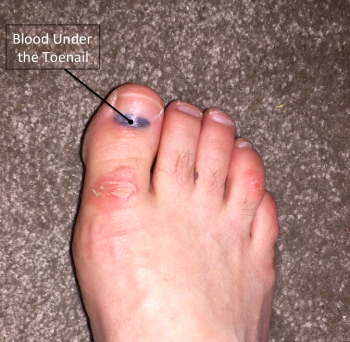Subungual Hematoma
(Bleeding under the toenail, Runner’s Toe)
Edited by Michael Shereff MD
Summary
Bleeding under the toenail (a subungual hematoma) is often associated with intense pain. It may occur after dropping an object on the toe or getting the toe caught between two hard surfaces. Alternatively, it may occur by repetitive trauma against the front of a shoe such as may occur in long-distance running (runner’s toe). It commonly involves the great toe although other toes may be involved. After being struck by an object, bleeding can occur in the nail bed trapping blood under the toenail. The pressure from the bleeding creates a space between the toenail and the underlying soft tissue (Matrix) that is intensely painful. Subungual hematomas are treated by releasing (decompressing) the collection of blood under the toenail. This helps relieve the pressure and associated pain. If this does not occur the bleeding may be resorbed over time or it may resolve over many months as the toenail grows out. In some instances, patients may lose the toenail although it will tend to grow back over time.
Clinical Presentation
A subungual hematoma occurs when trauma to the toenail causes bleeding under the toenail. Dropping a heavy object on the toe is one common cause, although repetitive trauma to the toenail from long-distance running in tight-fitting shoes (runner’s toe) may also cause a subungual hematoma. It is usually the great toe that is affected. This condition is characterized by intense pain. Bleeding or bruising under the toenail is seen — often at the base of the toenail.
Physical Examination
Blood that is often bluish in color will be seen under the toenail (Figure 1). Swelling of the toe itself is often seen. Movement or manipulation of the toenail will aggravate the pain. Occasionally blood will be seen leaking out the front or side of the toenail.
Figure 1: Subungual hematoma of the Great Toe

Imaging Studies
X-rays may be normal or they may demonstrate a fracture of the toe.
Treatment
Treating a subungual hematoma ideally involves relieving the pressure caused by the build-up of blood underneath the toenail. This is done by boring a hole through the top of the toenail and expressing the blood underneath. This is followed by icing, elevation, limiting standing and walking, and the use of a comfort shoe with a high wide toe box. If the blood is not released it will eventually solidify and over time as the toenail grows out, the blood will be resorbed. However, this may create dissociation between the toenail and the underlying soft tissue. In some cases, the subungual hematoma will cause the nail to fall off. If this occurs the toenail will be replaced over time with a new one. This occurs slowly at a rate of about 2mm/month.
Edited October 24, 2017
Previously edited by Stephen Pinney MD
mf/ 11.6.19